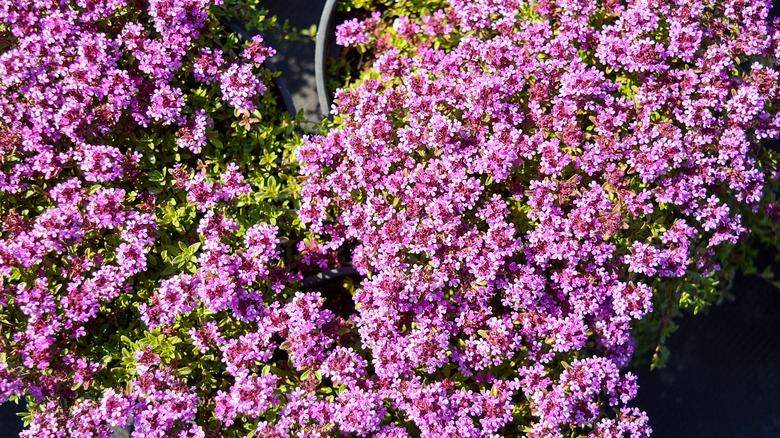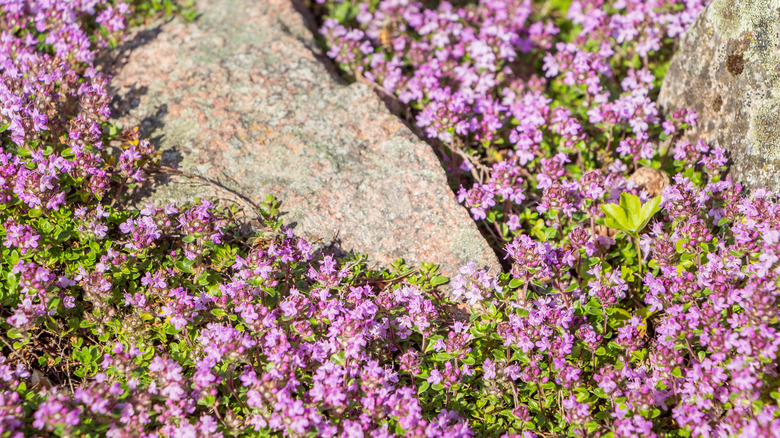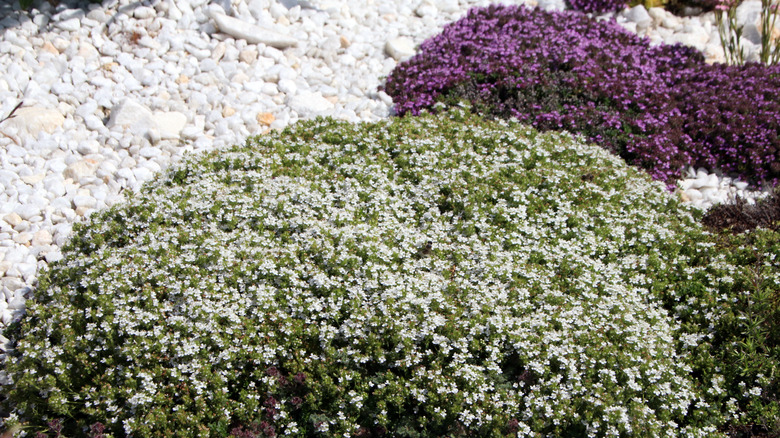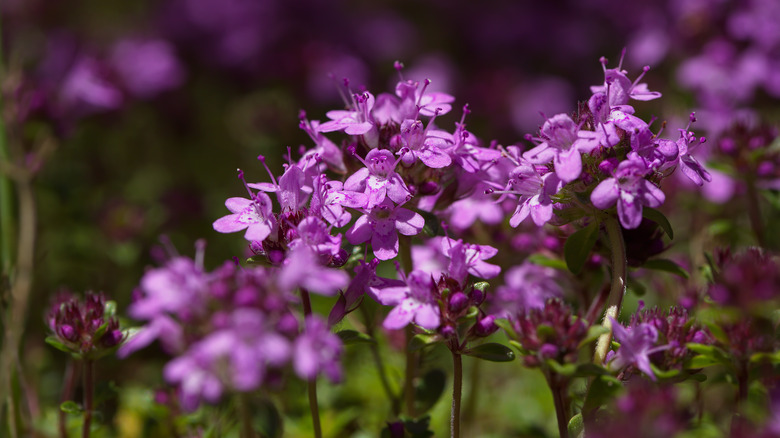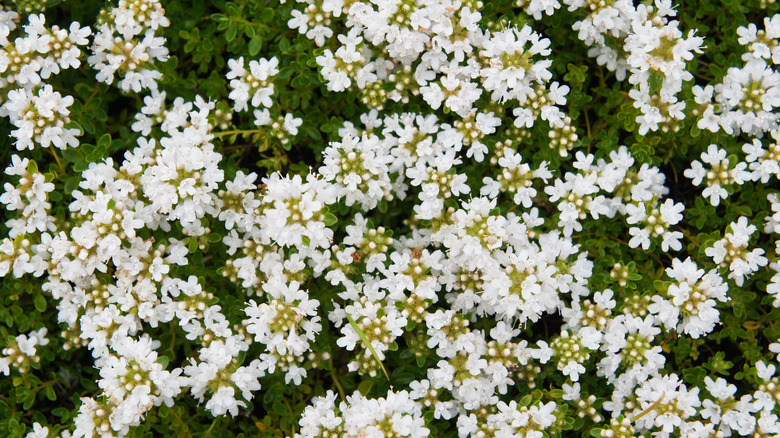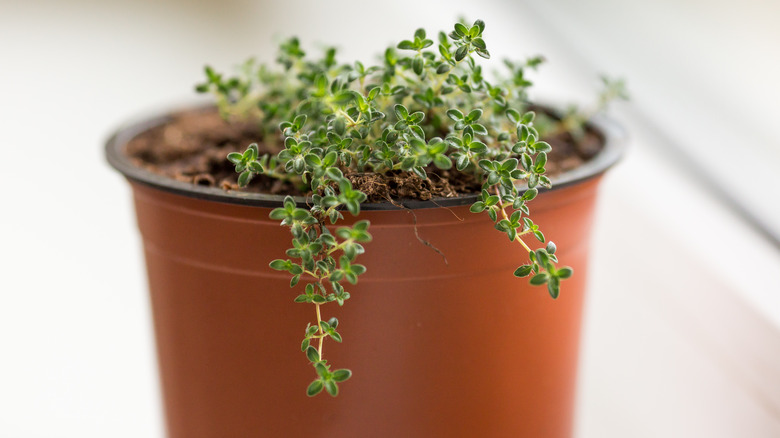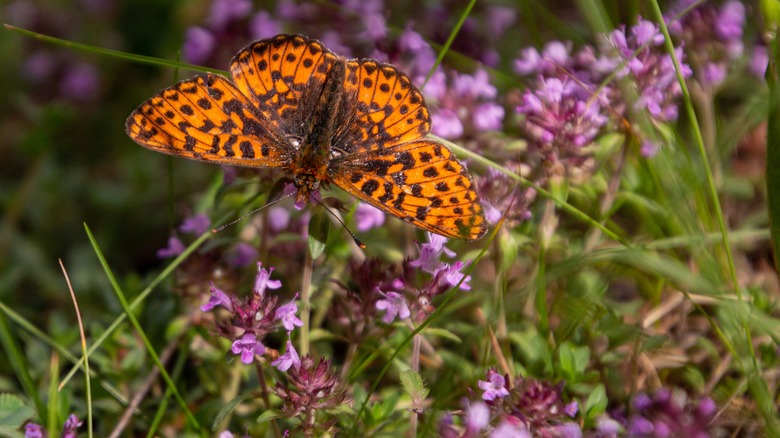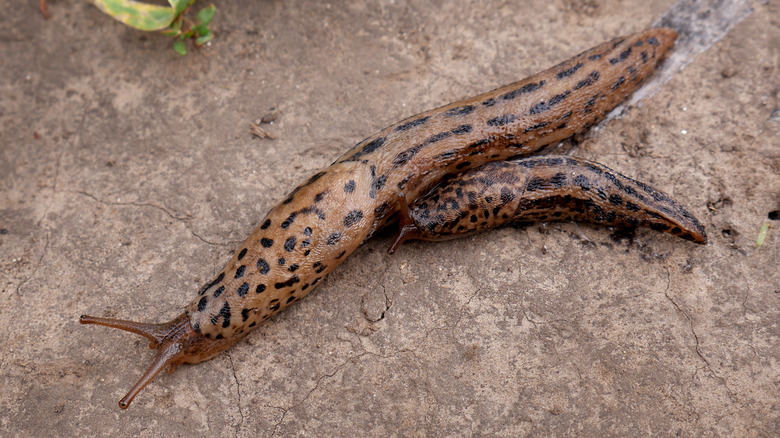How To Successfully Grow A Creeping Thyme Plant
The common name, creeping thyme, can refer to a few different species in the Thymus genus. Most often, however, creeping thyme points to Thymus praecox, also known as "mother of thyme." Native to most parts of Europe, as well as Africa and West Asia, Thymus praecox is an herbaceous perennial plant. It is easily grown and spreads rapidly, according to Gardening Know How. The plant is often found in USDA hardiness zones 4 through 9. Creeping thyme is low-growing and drought-tolerant. It features small pink or purple blooms and many green leaves covered with tiny hairs.
Creeping thyme is part of the mint family. Its leaves can be harvested for teas and some cuisines. Even as it sits in the garden, one can smell its fragrance. Yet, you should try not to confuse it with Thymus Vulgaris (common thyme), a close relative of creeping time, regularly used in the kitchen. More often than not, creeping thyme is planted for ground cover or to ward off some garden pests.
How to use creeping thyme in the garden
Creeping thyme can be planted in containers indoors, but it is happiest outside as it forms a low mat. Many experienced gardeners have planted this herb as a border plant, lawn substitute, or filler between garden spaces. You may even find it in a rock wall or between stones in a pathway, said Gardener's Path. Creeping thyme can handle quite a bit of foot traffic without dying. As you step on it, it releases its fragrance which is why lots of people choose it as ground cover. The plant will grow no taller than 3 inches, so you don't need to worry about it becoming too high.
In the garden, creeping thyme is great for warding off pests and attracting pollinators. This makes it an amazing plant to pair with vegetable and fruit plants. It will make sure rabbits and deer stay away while welcoming bees and butterflies. Interestingly, this thyme species can also crawl over ledges and rocks in certain conditions, as explained by The North Carolina State Gardener Plant Toolbox.
How to grow creeping thyme
To grow creeping thyme, you'll need to start by finding a sunny spot and well-draining soil. Textured soil is the best. Planting creeping thyme in an area that often sits in water is not a great idea. This will quickly kill it because the herb is susceptible to root rot, says Gardening Know How. You can grow creeping thyme from seeds or buy it as a start from your local nursery.
If you are growing from seeds, place them on the surface of the soil and cover them lightly. It's best to do this in the late spring when you can keep the soil moist and warm between 65 to 75 degrees Fahrenheit, as per The Spruce. In two to four weeks, you will begin to see the sprouts pop up from the dirt. When planting starts, be sure to place them at least eight inches apart so they may spread properly. Switch to fewer waterings as your herb grows.
To propagate creeping thyme, start by cutting off a 2-inch piece of stem with leaves only. Remove the leaves from the bottom inch. If you have rooting hormone on hand, you can choose to dip its cut end. Without rooting hormone, you will need to place the stem in water for at least three weeks until roots begin to grow. Finally, you can plant your propagated creeping thyme in the ground or into its pot.
How to care for creeping thyme
Caring for creeping thyme can be quite easy, especially if you plan to grow it outdoors in the right conditions. The key to caring for healthy creeping thyme is plenty of sun and poor soil. This plant can survive in partial shade, but it won't be happy about it. When you want quick growth, lots of direct sunlight will do the trick. Though creeping thyme will die if overwatered, it's important that you don't let it become parched either, explained The Spruce. When properly cared for, this plant is lightly watered once per week, depending on the weather in your area.
Because creeping thyme prefers lean soil, it will never need fertilizing. Even when it is grown indoors, it will not need feeding. In the first few years after planting, it will grow quite rapidly spreading out widely depending on how many plants you started with. Due to this, you will need to prune your creeping thyme to keep it healthy. The original parent plants, after some time, will grow leggy and thin. According to Gardener's Path, If you want to encourage more thick growth, dividing or thinning them out is best. Do this in the earlier part of spring to prepare your creeping thyme for the growing season.
Creeping thyme varieties
There are more than 350 species of plants in the Thymus genus, as per Gardener's Path. Each of them is native to central and southern Europe, but they have spread to several parts of the world with similar temperate Mediterranean climates. The following variations of creeping thyme all share the same low-growing characteristic that makes each of them great options for ground cover, path edging, and garden borders.
-
Thymus praecox 'minus' features extra small thyme leaves and equally tiny pink blooms. This cultivar forms thick mats that almost look like moss.
-
Thymus praecox 'pseudolanuginosus' is quite similar to creeping thyme growing to a height of about 3 inches and supporting pale pink flowers.
-
Thymus praecox 'Albus' or 'white moss thyme' has small, round, fragrant leaves and clusters of white flowers. It is often used in herb gardens.
-
Thymus praecox 'Doone Valley' or 'lemon thyme' is a hybrid version of creeping thyme, which has a distinct citrus smell.
-
Thymus praecox 'polytrichus' is a rare subspecies of creeping thyme. It originated from and is still most often found in Bosnia.
How to repot creeping thyme
Creeping thyme is easily divided and repotted. To divide this plant, you'll need to begin by gathering some supplies. Sterilized scissors, a clean, well-draining pot, and well-draining soil to start. As explained by The Spruce, your pot should be 3inches wider in diameter than the section of creeping thyme you plan to put inside it. From the ground, dig around the plant in a circle nearly 4 inches from its center. If you are taking your division from an old container, simply remove the creeping thyme and its root ball. Once you have your creeping thyme in hand, cut it in half with your scissors, avoiding its roots if possible. You may make more divisions; however, you should be sure that each section has plenty of healthy roots.
To repot your creeping thyme, fill the bottom of your planter with well-draining soil and set your root ball in the center. You should only use one plant per pot or one plant per square foot if you are using a larger container. Fill the rest of the planter with soil and gently pack it on top of the roots. Generously water your repotted thyme plant, and throw out any leftover water from the saucer. Finally, place your creeping thyme in a sunny part of your home or outdoors.
Possible health benefits of creeping thyme
Creeping Thyme is not on the ASPCA's dangerous plants list. It seems that it is non-toxic to dogs, cats, and horses, similar to other members of the Thymus genus according to the ASPCA. There is not much research on pets and the thymus praecox species specifically. However, we do know that common thyme is healthy for many household pets to eat, such as dogs, cats, and rabbits.
The American Kennel Club stated that thyme is antibacterial and antifungal because it contains thymol as an active ingredient. Feeding thyme plants to your pet may help your pet fight some illnesses. Small amounts certainly won't hurt them. It's best to feed your pet thyme in small doses. Even though the herb is generally recognized as safe, large ingestions of any plant can lead to an upset stomach and diarrhea. Thyme is safest for your pets when grown in your garden. This way you know that it is free of pesticides and other chemicals. Growing it yourself also ensures that they get their thyme fresh every time.
Creeping thymes' common pests and problems
Even though creeping thyme is quite simple to care for and tolerant of neglect, there are still a few problems you should watch for to keep a healthy plant. According to North Carolina Extension Gardener Plant Toolbox, the only pests that threaten creeping thyme are slugs. If you have your own vegetable garden, you may already have the tools to ward them off. Some great slug and snail repellents include copper tape, garlic oil, coffee grounds, salt, and Vaseline. Gardener's Path also suggested one great bait and trap idea. By filling a dish with beer, you can attract slugs to the smell of its yeast. The slugs will crawl into the dish to drink it and drown. In the morning, you can collect the dead slugs and set out a new bowl as needed.
Other than pests, you should also watch for brown leaves and drooping stems. This is indicative of root rot. Creeping thyme is very susceptible to root rot if you've been watering it too often or if its soil isn't draining properly. The plant can overcome this problem if it is caught early. When planted outside, you can decrease your watering schedule and make alterations to the area to help with drainage. Creeping thyme that is potted can be taken out of its pot and replanted into a better draining option. If you notice brown, mushy roots on your potted thyme, cut them off with sterile scissors before replanting.
